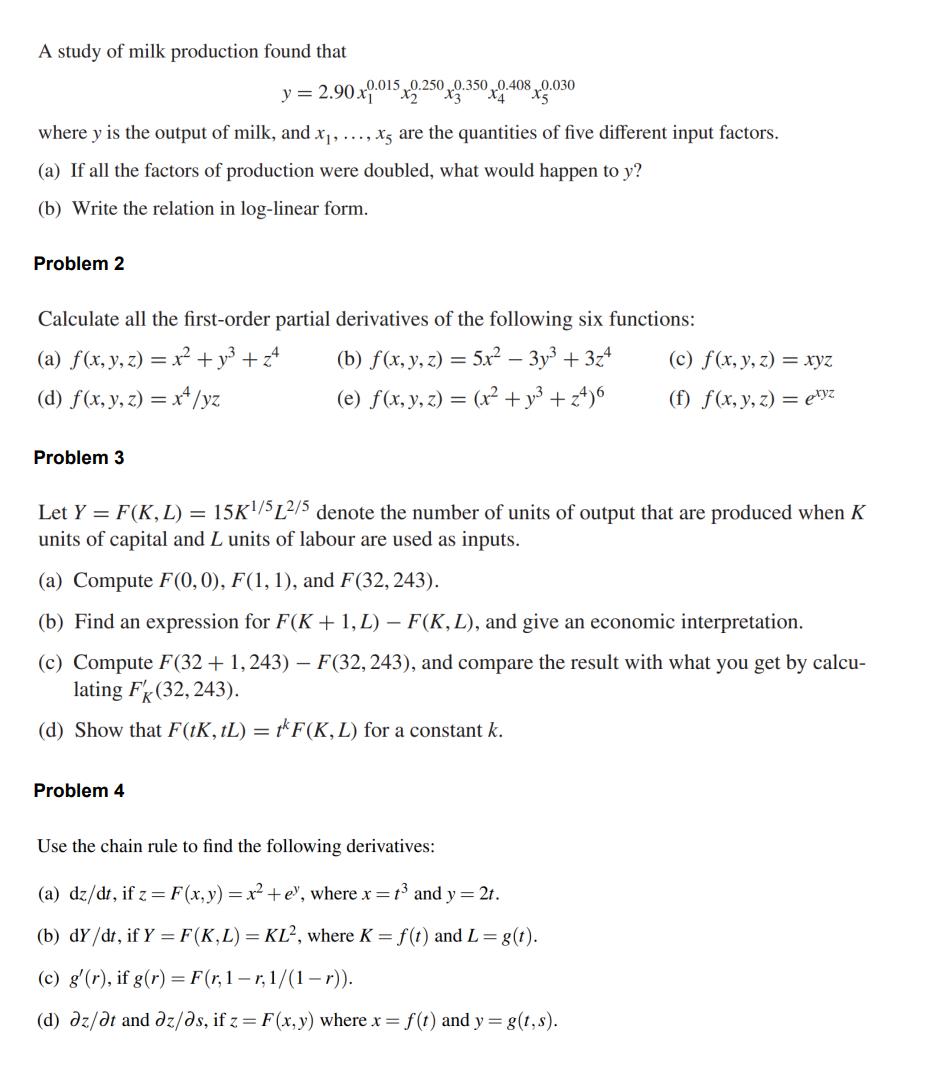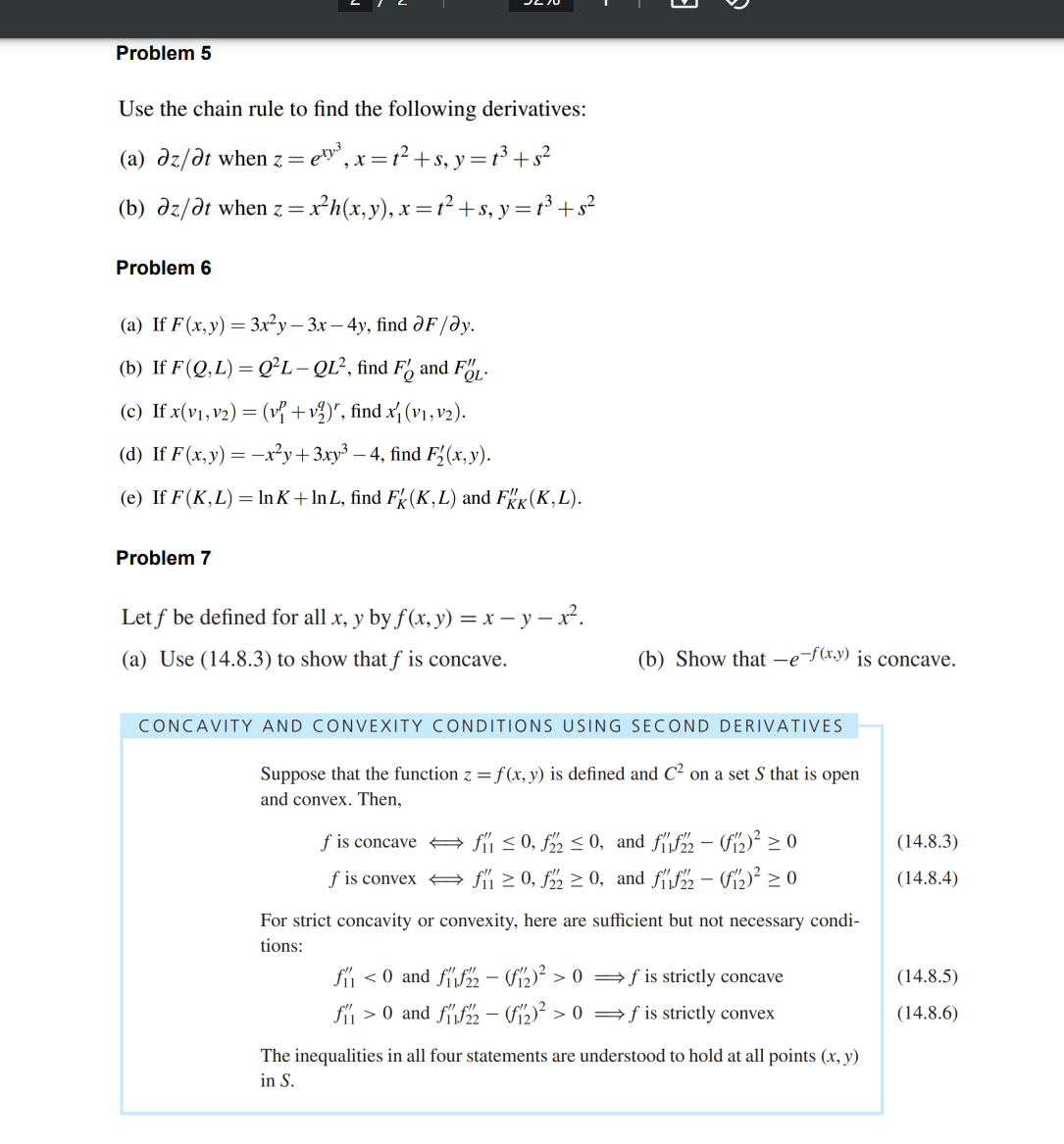Answered step by step
Verified Expert Solution
Question
1 Approved Answer
A study of milk production found that y= 2.90x0.015 0.250 0.350 0.408 0.030 X3 'x5' x4 where y is the output of milk, and


A study of milk production found that y= 2.90x0.015 0.250 0.350 0.408 0.030 X3 'x5' x4 where y is the output of milk, and x, ..., x5 are the quantities of five different input factors. (a) If all the factors of production were doubled, what would happen to y? (b) Write the relation in log-linear form. Problem 2 Calculate all the first-order partial derivatives of the following six functions: (a) f(x, y, z) = x+ y + z 4 (d) f(x, y, z) = x/yz Problem 3 (b) f(x, y, z) = 5x - 3y3+3z4 (c) f(x, y, z) = xyz (e) f(x, y, z) = (x + y +z+)6 (f) f(x, y, z) = exyz Let Y = F(K, L) = 15K1/5 2/5 denote the number of units of output that are produced when K units of capital and L units of labour are used as inputs. (a) Compute F(0,0), F(1, 1), and F(32, 243). (b) Find an expression for F(K + 1, L) - F(K, L), and give an economic interpretation. (c) Compute F(32 + 1,243) lating FK (32, 243). F(32, 243), and compare the result with what you get by calcu- (d) Show that F(tK, tL) = F(K,L) for a constant k. Problem 4 Use the chain rule to find the following derivatives: (a) dz/dt, if z= F(x,y) = x+e, where x = 13 and y = 2t. (b) dy/dt, if Y=F (K,L) = KL, where K = f(t) and L = g(t). (c) g'(r), if g(r) = F(r,1-r, 1/(1 r)). (d) az/t and z/as, if z = F(x,y) where x = f(t) and y = g(t,s). B Problem 5 Use the chain rule to find the following derivatives: (a) z/t when z = = e, x = t + s, y = t +s (b) z/t when z=. z= xh(x, y), x=t+s, y = t+s Problem 6 (a) If F(x,y) = 3xy-3x-4y, find OF/dy. == - (b) If F (Q, L) = QL QL, find F and FL (c) If x(v1, v2) = (v +v2)", find x1 (v1, v2). (d) If F(x, y) = xy+3xy 4, find F2(x, y). (e) If F (K,L) = InK+InL, find Fk (K,L) and FKK (K,L). Problem 7 Let f be defined for all x, y by f(x, y) = x y x. (a) Use (14.8.3) to show that f is concave. (b) Show that-e-f(x,y) is concave. CONCAVITY AND CONVEXITY CONDITIONS USING SECOND DERIVATIVES Suppose that the function z = f(x, y) is defined and C on a set S that is open and convex. Then, f is concave f is convex f0, f0, and f22 - (12) 0 f 0, 0, and - (f) 0 (14.8.3) (14.8.4) For strict concavity or convexity, here are sufficient but not necessary condi- tions: f0 and ff - (F12) > >0 f is strictly concave f">0 and ff (12) > 0 f is strictly convex The inequalities in all four statements are understood to hold at all points (x, y) in S. (14.8.5) (14.8.6)
Step by Step Solution
There are 3 Steps involved in it
Step: 1
Sure lets work through these problems one by one Problem 1 Given the production function y 290 x10015 x20250 x30350 x40408 x50030 a Doubling the factors of production If we double all the input factor...
Get Instant Access to Expert-Tailored Solutions
See step-by-step solutions with expert insights and AI powered tools for academic success
Step: 2

Step: 3

Ace Your Homework with AI
Get the answers you need in no time with our AI-driven, step-by-step assistance
Get Started


